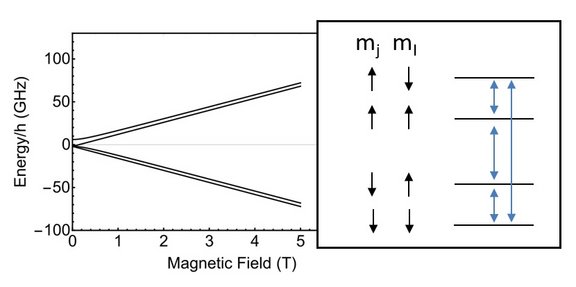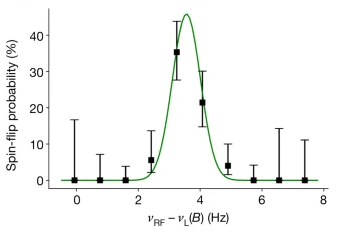μTEx
Among others μTEx is one of the worldwide leading experiments to investigate nuclear properties using single ions in a Penning trap [1]. At the experiment measurements with a precision of 1 part in a trillion enable the determination of magnetic moments, sizes and weights of single charged atoms. To this end methods such as sympathetic laser cooling, microwave spectroscopy and quantum jump spectroscopy are combined within one of the most stable superconducting magnets [2].
References
| [1] | A. Schneider et al., Nature 606, 878 (2022) |
| [2] | A. Schneider et al., Ann. Phys. 531, 1800485 (2019) |
Precise knowledge of the magnetic and structural properties of matter at the atomic and nuclear scale is of paramount importance both for our fundamental understanding of physics and for practical applications such as nuclear magnetic resonance probes. This results in a variety of objectives in different projects, which we pursue in our experiment. These include:
- High-precision measurement of the magnetic moments of single nuclei as well as electrons bound to nuclei
- Determination of fundamental constants of nature – e.g. the mass of the tritium nucleus and the electron
- Tests of the Standard Model of particle physics
- Test of the predictive power of quantum electrodynamics
- Review of models describing effects of nuclear structure
- Development of innovative techniques in precision physics, e.g. laser cooling and voltage sources employing superconducting integrated circuits
The core of the apparatus is a so-called Penning trap. A Penning trap is a precisely manufactured measuring instrument that enables the storage and non-destructive observation of ions. For this purpose, the Penning trap is used to create a precisely defined superposition of static electric and static magnetic fields, which allows individual ions to be stored in their interior.
Subsequently, the ion together with the trap forms an artificially produced atom, which can be manipulated in a variety of ways and examined with a wide variety of methods.
Figure 1 shows the energy levels of a single helium-3 ion stored in the Penning trap. In addition to the properties of the Penning trap that we have defined, the energy levels depend on the specific properties of the helium ion. The result is that the properties of the ion can be derived from the precise measurement of these energy levels. This makes it possible to measure the mass, the magnetic moment and the size of the ion.
As shown in Figure 2, the measurements are carried out in a tower of several Penning traps consisting of cylindrical electrodes [3]. The ions can be produced within the trap using different methods. On the one hand, a glass sphere can be heated so that gaseous atoms such as helium penetrate the glass and are then ionized with the help of an electron beam. On the other hand, an intense laser beam can be directed onto a solid to ignite a plasma.
The trap tower is placed in the cold bore of a 5 T superconducting magnet and cooled to 4 K by thermal contact with liquid helium. In order to be able to excite spin-flips of electrons bound to nuclei, microwaves of frequency 150 GHz are coupled into the setup by a waveguide. In addition, optical access allows ultraviolet laser radiation to be irradiated in order to cool the ions to a few mK.
Reference
| [3] | A. Mooser et al., J. Phys.: Conf. Ser. 1138, 012004 (2018) |
In a first study, see [1], we investigated the magnetic properties of the helium-3 isotope, compare Figure 3. Here for the first time, it was possible to directly measure the electron and nuclear magnetic moments of the helium-3 ion with a relative accuracy of 10-10. With an accuracy improved by two orders of magnitude, the magnetic interaction between the electron and the nucleus (zero-field hyperfine splitting) was determined. In addition, the size of a helium-3 nucleus could be determined. The results represent the first direct calibration for helium-3 nuclear magnetic resonance (NMR) probes and are thus groundbreaking in the metrology of magnetic fields.
Reference
| [1] | A. Schneider et al., Nature 606, 878 (2022) |
For the future, we can expect a large number of technically innovative and scientifically interesting projects to put our previous understanding of physics to the test and at the same time search for new physical phenomena.
In a first step, the direct measurement of the magnetic moment of the naked helium-3 nucleus in a Penning trap with a relative accuracy of the order of 1 ppb or better is planned. To this end, we will integrate sympathetic laser cooling as well as voltage sources based on the superconducting Josephson effect into the experiment [4].
In addition, other light isotopes will be investigated in order to carry out precise tests of quantum electrodynamics, to determine fundamental masses such as those of the tritium nucleus or the electron, as well as to verify models for the description of nuclear effects.
Reference
| [4] | M. Bohman et al., Nature 596,514 (2021) |
μTEx Group Leader
- Dr. Andreas Mooser, MPIK Heidelberg
Phone: +49 6221 516-653 | E-Mail
μTEx Members
- Ute Beutel, MPIK Heidelberg
Phone: +49 6221 516-226 | E-Mail - Stefan Dickopf, MPIK Heidelberg
Phone: +49 6221 516-226 | E-Mail - Anton Gramberg, MPIK Heidelberg
Phone: +49 6221 516-226 | E-Mail - Philipp Justus, MPIK Heidelberg
Phone: +49 6221 516-683 | E-Mail - Annabelle Kaiser, MPIK Heidelberg
Phone: +49 6221 516-653 | E-Mail - Ankush Kaushik, external
Phone: +49 6221 516-226 | E-Mail - Marius Müller, MPIK Heidelberg
Phone: +49 6221 516-683 | E-Mail
7Precision spectroscopy on 9Be overcomes limitations from nuclear structure
S. Dickopf, B. Sikora, A. Kaiser, M. Müller, S. Ulmer, V. A. Yerokhin, Z. Harman, C. H. Keitel, A. Mooser, and K. Blaum
Nature 632, 757-761 (2024)
MPIK press release: Through the spaceship atom's shield
MPIK-Pressemitteilung: Durch den Schutzschild des Raumschiffs Atom
idw press release: Through the spaceship atom's shield
Publisher Correction
6Josephson voltage standards as ultra-stable low-noise voltage sources for precision Penning-trap experiments
A. Kaiser, S. Dickopf, M. Door, R. Behr, U. Beutel, S. Eliseev, A. Kaushik, K. Kromer, M. Müller, L. Palafox, S. Ulmer, A. Mooser, and K. Blaum
Applied Physics Letters 124, 224002 (2024)
5Direct measurement of the 3He+ magnetic moments
A. Schneider, B. Sikora, S. Dickopf, M. Müller, N. S. Oreshkina, A. Rischka, I. A. Valuev, S. Ulmer, J. Walz, Z. Harman, C. H. Keitel, A. Mooser, and K. Blaum
Nature 606, 878-883 (2022)
MPIK press release: How magnetic is helium-3?
MPIK-Pressemitteilung: Wie magnetisch ist Helium-3?
phys.org: Investigating the magnetic properties of helium-3
4A Novel Penning‐Trap Design for the High‐Precision Measurement of the 3He2+ Nuclear Magnetic Moment
A. Schneider, A. Mooser, A. Rischka, K. Blaum, S. Ulmer, and J. Walz
Annalen der Physik 531, 1800485 (2019)
3A New Experiment for the Measurement of the g-Factors of 3He+ and 3He2+.
A. Mooser, A. Rischka, A. Schneider, K. Blaum, S. Ulmer, and J. Walz
Journal of Physics: Conference Series 1138, 012004 (2018)
2Sympathetic cooling of protons and antiprotons with a common endcap Penning trap.
M. Bohman, A. Mooser, G. Schneider, N. Schön, M. Wiesinger, J. Harrington, T. Higuchi, H. Nagahama, C. Smorra, S. Sellner, K. Blaum, Y. Matsuda, W. Quint, J. Walz, and S. Ulmer
Journal of Modern Optics 65, 601-609 (2018)
1Double-trap measurement of the proton magnetic moment at 0.3 parts per billion precision.
G. Schneider, A. Mooser, M. Bohman, N. Schön, J. Harrington, T. Higuchi, H. Nagahama, S. Sellner, C. Smorra, K. Blaum, Y. Matsuda, W. Quint, J. Walz, and S. Ulmer
Science 358, 1081-1084 (2017)



